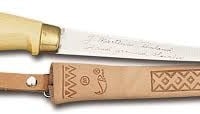This is a tough one because knife choice is so much down to personal preference, they type of fish you fillet, filleting methods, etc.
I have noticed that there seems to be a conflict between how flexible a knife is and how long it holds an edge. The very flexible knife I own, a Rapala Limited Edition by some Finnish cutlery maker doesn’t hold an edge very well. My other knife is a Buck, which takes a fantastic edge, but it much less flexible than the Rapala.
I’m not sure if there is middle ground here, or if greater flex means softer steel, which means less edge retention?
For sharpening, I’ve never been quite sure why people seem to agonize so much over knife sharpening? I’ve even had foodies tell me in all honesty that you can “ruin” a knife by not having a factory-authorized place sharpen it. Cobblers!
There are dozens of good ceramic sharpening systems out there. I bought one 15 years ago for less than $30. Combined with a fine wetstone and a strop, it puts a razor edge on anything. If you’re a woodworker, you should already have everything you need to sharpen plane irons and chisels, but if not stones are not very expensive. If you don’t have a leather strop, a piece of paper from a brown grocery bag held on a flat piece of glass works just fine for that final touch.
What I’ve found for all knives is that it’s vastly easier to sharpen knives if you keep them sharp in the first place. It takes 15 minutes to touch up every kitchen knife I own. It’s really easy to keep things sharp.
But if someone really dulls one, like say my mother takes my 6 inch Global chef knife and cuts something on a glass tray instead of a cutting board and dulls the royal crap out of it. In that case, it takes 15 minutes just to put an edge back on that one knife with the sharpener and a waterstone.
Grouse
